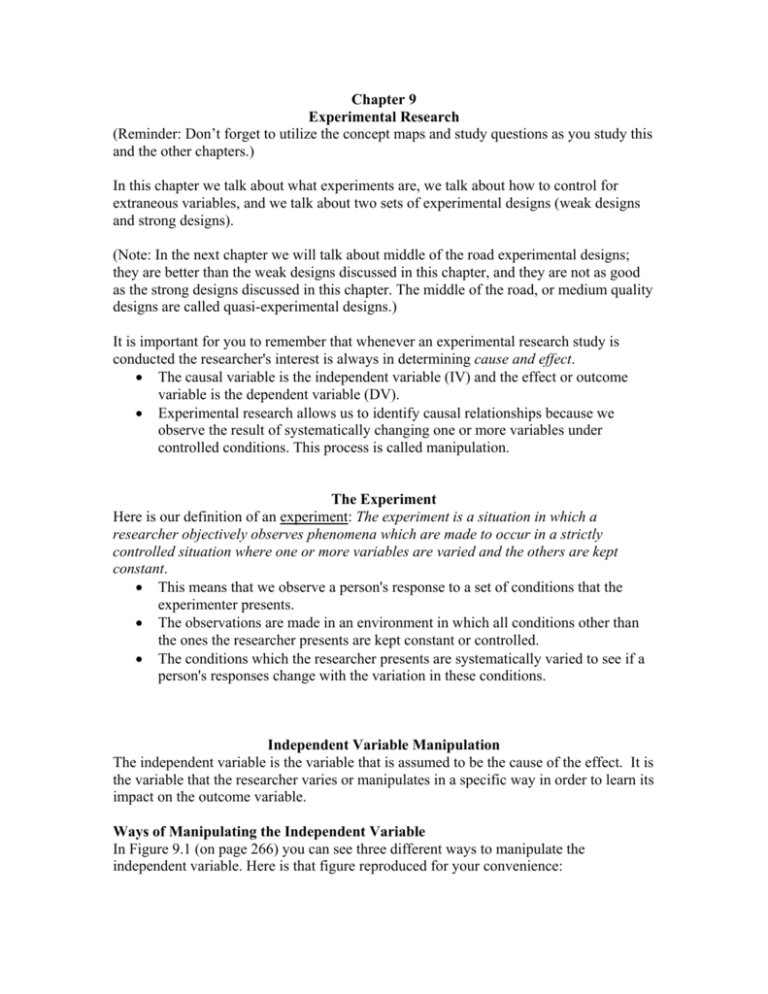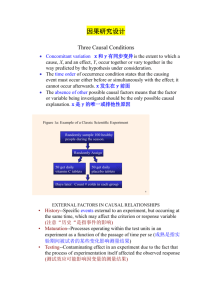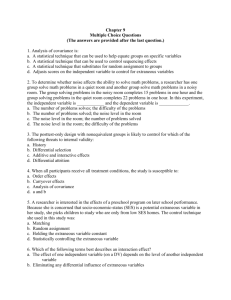Chapter 8 - University of South Alabama
advertisement

Chapter 9 Experimental Research (Reminder: Don’t forget to utilize the concept maps and study questions as you study this and the other chapters.) In this chapter we talk about what experiments are, we talk about how to control for extraneous variables, and we talk about two sets of experimental designs (weak designs and strong designs). (Note: In the next chapter we will talk about middle of the road experimental designs; they are better than the weak designs discussed in this chapter, and they are not as good as the strong designs discussed in this chapter. The middle of the road, or medium quality designs are called quasi-experimental designs.) It is important for you to remember that whenever an experimental research study is conducted the researcher's interest is always in determining cause and effect. • The causal variable is the independent variable (IV) and the effect or outcome variable is the dependent variable (DV). • Experimental research allows us to identify causal relationships because we observe the result of systematically changing one or more variables under controlled conditions. This process is called manipulation. The Experiment Here is our definition of an experiment: The experiment is a situation in which a researcher objectively observes phenomena which are made to occur in a strictly controlled situation where one or more variables are varied and the others are kept constant. • This means that we observe a person's response to a set of conditions that the experimenter presents. • The observations are made in an environment in which all conditions other than the ones the researcher presents are kept constant or controlled. • The conditions which the researcher presents are systematically varied to see if a person's responses change with the variation in these conditions. Independent Variable Manipulation The independent variable is the variable that is assumed to be the cause of the effect. It is the variable that the researcher varies or manipulates in a specific way in order to learn its impact on the outcome variable. Ways of Manipulating the Independent Variable In Figure 9.1 (on page 266) you can see three different ways to manipulate the independent variable. Here is that figure reproduced for your convenience: • • • First, the independent variable can be manipulated by presenting a condition or treatment to one group of individuals and withholding the condition or treatment from another group of individuals. This is the presence or absence technique. Second, the independent variable can be manipulated by varying the amount of a condition or variable such as varying the amount of a drug which is given to children with a learning disorder. This is the amount technique. A third way of manipulating the independent variable is to vary the type of the condition or treatment administered. One type of drug may be administered to one group of learning disabled children and another type of drug may be administered to another group of learning disabled children. This is the type technique. Control of Confounding Variables Potential confounding variables can be controlled for by using of one or more of a variety of techniques that eliminate the differential influence an extraneous variable may have for the comparison groups in a research study. • Differential influence occurs when the influence of an extraneous variable is different for the various comparison groups. • For example, if one group is mostly females and the other group is mostly males, then the gender may have a differentially effect on the outcome. As a result, you will not know whether the outcome is due to the treatment or due to the effect of gender. • If the comparison groups are the same on all extraneous variables at the start of the experiment, then differential influence is unlikely to occur. • In experiments, we want our groups to be the same (or “equivalent” on all potentially confounding extraneous variables). The control techniques are essentially attempts to make the groups similar or equivalent. Remember this important point: You want all of your comparison groups to be similar to each other (on all characteristics or variables) at the start of an experiment. Then, after manipulating the independent variable you will be better able to attribute the difference observed at the posttest to the independent variable because one group got a treatment and the other group did not. • You want the only systematic difference between the groups in an experiment to be the variation of the independent variable. You want the groups to be the same on all other variables (i.e., the same on extraneous or confounding variables). Now we will discuss these six techniques that are used to control for confounding variables: random assignment, matching, holding the extraneous variable constant, building the extraneous variable into the research design, counterbalancing, and analysis of covariance. Random Assignment Random assignment is the most important technique that can be used to control confounding variables because it has the ability to control for both known and unknown confounding extraneous variables. Because of this characteristic, you should randomly assign whenever and wherever possible. • Random assignment makes the groups similar on all variables at the start of the experiment. • If random assignment is successful, the groups will be mirror images of each other. You must be careful not to confuse random assignment with random selection! The two techniques differ in purpose. (Note: I strongly recommend that you re-read the section titled Random Selection and Ransom Assignment on pages 216-217; it is only three paragraphs long, but will help you with this very important distinction!) • • • • The purpose of random selection is to generate a sample that represents a larger population. This topic was covered in our earlier chapter on Sampling (Chapter 7). The purpose of random assignment is to take a sample (usually a convenience sample) and use the process of randomization to divide it into two or more groups that represent each other. That is, you use random assignment to create probabilistically “equivalent” groups. Note that random selection (randomly selecting a sample from a population) helps ensure external validity, and random assignment (randomly dividing a set of people into multiple groups) helps ensure internal validity. Because the primary goal is experimental research is to establish firm evidence of cause and effect, random assignment is more important than random selection in experimental research. It that is counterintuitive to you, then please reread it as many times as is necessary. Random assignment controls for the problem of differential influence (that was discussed earlier). It does they by insuring that each participant has an equal chance of being assigned to each comparison group. • In other words, random assignment eliminates the problem of differential influence by making the groups similar on all extraneous variables. • The equal probability of assignment means that not only are participants equally likely to be assigned to each comparison group but that the characteristics they bring with them are also equally likely to be assigned to each comparison group. • This means that the research participants and their characteristics should be distributed approximately equally in all comparison groups! • Again, random assignment is the best way to create equivalent groups for use in experimental research. Here is one way to carry out random assignment that we included in the first edition of our textbook: Another way to conduct random assignment is to assign each person in your sample a number and then use a random assignment computer program. Here is one: http://www.graphpad.com/quickcalcs/randomize1.cfm Matching Matching controls for confounding extraneous variables by equating the comparison groups on one or more variables that are correlated with the dependent variable. • What you have to do is to decide what extraneous variables you want to match on (i.e.., decide what specific variables you want to make your groups similar on). These variables that you decide to use are called the matching variables. • Matching controls for the matching variables. That is, it eliminates any differential influence of the matching variables. • You can match your groups on one or more extraneous variables. • For example, let’s say that you decide to equate your two groups (treatment and control group) on IQ. That is, IQ is going to be your only matching variable. What you would do is to rank order all of the participants on IQ. Then select the first two (i.e., the two people with the two highest IQs) and put one in the experimental treatment group and the other in the control group (The best way to do this is to use random assignment to make these assignments. If you do this then you have actually merged two control techniques: matching and random assignment). Then take the next two highest IQ participants and assign one to the experimental group and one to the control group. Then just continue this process until you assign one of the lowest IQ participants to one group and the other lowest IQ participant to the other group. Once you have completed this, your two groups will be matched on IQ! If you use matching without random assignment, you run into the problem that although you know that your groups are matched on IQ you have not matched them on other potentially important variables. • A weakness of matching when it is used alone (i.e., without also using random assignment) is that you will know that the groups are equated on the matching variable(s) but you will not know whether the groups are similar on other potentially confounding variables. Holding the Extraneous Variable Constant This technique controls for confounding extraneous variables by insuring that the participants in the different treatment groups have the same amount or type on a variable. • For example, you might use only people who have an IQ of 120-125 in your research study if you are worried about IQ as being a confounding variable. • If you are worried about gender, this if you used this technique you would either study females only or males only, but not both. • A problem with this technique it that it can seriously limit your ability to generalize your study results (because you have limited your participants to only one type). Building the Extraneous Variable into the Research Design This technique takes a confounding extraneous variable and makes it an additional independent variable in your research study. • For example, you might decide to include females and males in your research study. • This technique is especially useful when you want to study any effect that the potentially confounding extraneous variable might have (i.e., you will be able to study the effect of your original independent variable as well as the additional variable(s) that you built into your design. Counterbalancing Counterbalancing is a technique used to control for sequencing effects (the two sequencing effects are order effects and carry-over effects). • Note that this technique is only relevant for a design in which the participants receive more than one treatment condition (e.g., such as the repeated measures design that is discussed later in the chapter) • Sequencing effects are biasing effects that can occur when each participant must participate in each experimental treatment condition.. • Order effects are sequencing effects that arise from the order in which the treatments are administered. For example, as people complete their participation in their first treatment condition they will become more familiar with the setting and testing process. When these people participate, later, in their second treatment condition, they may perform better simply because are now familiar with the setting and testing that they acquired earlier. This is how the order can have an effect on the outcome. Order effects that need to be controlled. • Carry-over effects are sequencing effects that occur when the effect of one treatment condition carries over to a second treatment condition. That is, participants’ performance in a later treatment is different because of the treatment that occurred prior to it. When this occurs the responses in subsequent treatment conditions are a function of the present treatment condition as well as any lingering effect of the prior treatment condition. Learning from the earlier treatment might carry-over to later treatments. Physical conditions caused by the earlier treatment might also carry-over if the time elapsing between the treatments is not long enough for the earlier effect to dissipate. • • • Here is the good news! Counterbalancing is a control technique that can be used to control for order effects and carry-over effects. You counterbalance by administering each experimental treatment condition to all groups of participants, but you do it in different orders for different groups of people. For example if you just had two groups making up your independent variable you could counterbalance by dividing you sample into two groups and giving this order to the first group (treatment one followed by treatment two) and giving this order to the second group (treatment two followed by treatment one). Analysis of Covariance Analysis of covariance (ANCOVA) is a statistical control technique that is used to statistically equate groups that differ on a pretest or some other variable. • For example, in multigroup designs that have a pretest, ANCOVA is used to equate the groups on the pretest. • As another example, in a learning research study you might want to control for intelligence because if there are more brighter students in one of two comparison groups (and these students are expected to learn faster) then the difference between the groups might be because the groups differ on IQ rather than the treatment variable; therefore, you would want to control for intelligence. • Analysis of covariance statistically adjusts the dependent variable scores for the differences that exist on an extraneous variable (your control variable). • When selecting variables to control for, note that the only relevant extraneous variables are those that also affect participants' responses to the dependent variable. Experimental Research Designs A research design is the outline, plan, or strategy that you are going to use to obtain an answer to your research question. Research designs can be weak or strong (or quasi which are moderately strong; that is, in between the weak and the strong designs) depending on the extent to which they control for the influence of confounding variables. Weak Experimental Research Designs Some research designs are considered weak because they do not control for the influence of many confounding variables. The one-group posttest-only design is a very weak research design where one group of research participants receives an experimental treatment and is then post tested on the dependent variable. • A serious problem with this design is that you do not know whether the treatment condition had any effect on the participants because you have no idea as to what • their response would be if they were not exposed to the treatment condition. That is, you don’t have a pretest or a control group to make your comparison with. Another problem with this design is that you do not know if some confounding extraneous variable affected the participants' responses to the dependent variable. Because of the problems with this design it generally gives little evidence as to the effect of the treatment condition. The next design is the one-group pretest-posttest design. Here is a depiction of it: • • • • The one-group pretest-posttest design is a research design where one group of participants is pretested on the dependent variable and then posttested after the treatment condition has been administered. This is a better design than the one-group posttest-only design because it at least includes a pretest, that indicates how the participants did prior to administration of the treatment condition. In this design, the effect is taken to be the difference between the pretest and posttest scores. It does not control for potentially confounding extraneous variables such as history, maturation, testing, instrumentation, and regression artifacts, so it is still difficult to identify the effect of the treatment condition. The next of the weak experimental research designs is the posttest-only design with nonequivalent groups. • Here is its depiction: • • The posttest-only design with nonequivalent group includes an experimental group that receives the treatment condition and a control group that does not receive the treatment condition or receives some standard condition and both groups are posttested on the dependent variable. While this design includes a control group (which gives something to compare the treatment group with), the participants are not randomly assigned to the groups so • there is little assurance that the two groups are equated on any potentially confounding variables prior to the administration of the treatment condition. Because the participants were not randomly assigned to the comparison groups, this design does not control for differential selection, differential attrition, and the various additive and interaction effects For a summary of the threats to validity for the weak experimental designs, you should study Table 9.1 on page 277. Strong Experimental Research Designs A research design is considered to be a "strong research design" if it controls for the influence of confounding extraneous variables. This is typically accomplished by including one or more control techniques into the research design. • The most important of these control techniques is random assignment. • In addition to including control techniques, strong research designs include a control group which is the comparison group that either does not receive the experimental treatment condition or receives some standard treatment condition. • I will briefly discuss these strong designs: the pretest-posttest control-group design, the posttest-only control-group design, the factorial design, the repeated measures design, and the factorial design based on a mixed model. (For a summary of all of these, look at and study Table 9.2 on page 281.) The first strong experimental design is the pretest-posttest control-group design. Here is a picture of it in its basic form: • • The pretest-posttest control-group design is a strong research design in which a group of research participants is randomly assigned to an experimental and control group. Both groups of participants are pre tested on the dependent variable and then post tested after the experimental treatment condition has been administered to the experimental group. This is an excellent research design because it includes a control or comparison group and has random assignment. • • This design controls for all of the standard threats to internal validity. Differential attrition may or may not be a problem depending on what happens during the conduct of the experiment. Note that while this design is often presented as a two group design, it can be expanded to include a control group and as many experimental groups as are needed to test your research question. The next strong experimental research design is the posttest-only control group design. Here is a picture of it: The posttest-only control group design is a research design in which the research participants are randomly assigned to an experimental and control group and then post tested on the dependent variable after the experimental group has received the experimental treatment condition. • This is an excellent research design because it includes a control or comparison group and has random assignment. • Just like the previous design, it controls for all of the standard threats to internal validity. Differential attrition may or may not be a problem depending on what happens during the conduct of the experiment. • This design does not include a pretest of the dependent variable, but this does not detract from its internal validity because it includes the control group and random assignment which means that the experimental and control groups are equated at the outset of the experiment. The next strong experimental research design is the factorial design. For a depiction of this design, please go to page 281 and look at it in Table 9.2. The layout for a factorial design with two independent variables (Type of instruction and level of anxiety) is shown in Figure 9.14 (p.287) and here for your convenience. • • • • • • • A factorial design is a design in which two or more independent variables are simultaneously investigated to determine the independent and interactive influence which they have on the dependent variable. It also has random assignment to the groups. Each combination of independent variables is called a "cell." Research participants are randomly assigned to as many groups are there are cells of the factorial design if both of the independent variables can be manipulated. The research participants are administered the combination of independent variables that corresponds to the cell to which they have been assigned and then they respond to the dependent variable. The data collected from this research give information on the effect of each independent variable separately and the interaction between the independent variables. The effect of each independent variable on the dependent variable is called a main effect. There are as many main effects in a factorial design as there are independent variables. If a research design included the independent variables of gender and type of instruction, then there would potentially be two main effects, one for gender and one for type of instruction. An interaction effect between two or more independent variables occurs when the effect which one independent variable has on the dependent variable depends on the level of the other independent variable. For example, if gender is one independent variable and method of teaching mathematics is another independent variable, an interaction would exist if the lecture method was more effective for teaching males mathematics and individualized instruction was more effective in teaching females mathematics. The next strong experimental research design is the repeated-measures design. Here is a picture of it in its basic form with counterbalancing: • • • • • A repeated-measures design is a design in which all research participants receive all experimental treatment conditions. For example, if you were investigating the effect of type of instruction on learning mathematics and you used two types of instruction (lecture method and individualized instruction) the participants would experience both types of instruction, first one and then the other. This design has the advantage of requiring fewer participants than other designs because the same participants participate in all experimental conditions. This design also has the advantage of the participants in the various experimental groups being equated because they are the same participants in all of the treatment conditions. If you use counterbalancing with this design, then all of the standard threats to internal validity are controlled for. Differential attrition may or may not be a problem depending on what happens during the conduct of the experiment. The last strong experimental research design discussed in this chapter is the factorial design based on a mixed model. Here is a picture of this design when it has two independent variables: • • • The factorial design based on a mixed model is a factorial design in which different participants are randomly assigned to the different levels of one independent variable but all participants take all levels of another independent variable. In the depiction above, participants are randomly assigned to variable B, and all participants receive all levels of variable A. All of the standard threats to internal validity are controlled for with this design if conuterbalancing is used for the repeated measures independent variable. Differential attrition may or may not be a problem depending on what happens during the conduct of the experiment. As you study the designs in this chapter, two tables will be of maximum help. • Table 9.1 on page 277 shows the depictions of all of the weak experimental research designs and the threats to internal validity for each of these designs. • Table 9.2 on page 281 shows the depictions of all of the strong experimental research designs and the threats to internal validity for each of these designs. Here are copies of these two tables for your convenience.





